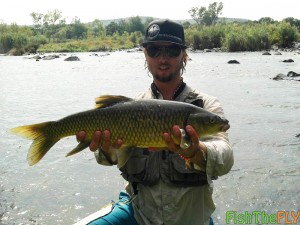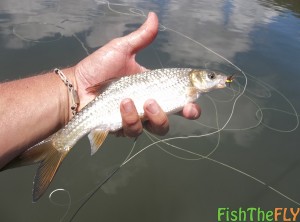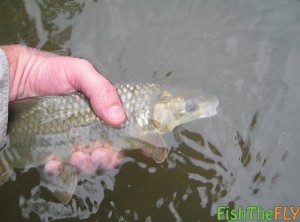Yellowfish Spawning: When Do Yellowfish Spawn?
Spawning Information On South Africa’s Yellowfish
An Introduction To Breeding Yellowfish
Yellowfish Spawning: Yellowfish spawn, generally, after the first heavy rains of the Yellowfish season. The Yellowfish start moving into shallow water at the start of Spring/Summer when the water reaches 16 degrees celsius. They move into these more shallow, warm waters not only to feed, but also in preparation for spawning, which normally takes place after the first heavy rains or sparsely, between October and February.
The spawning season is a long and drawn out affair, and depends heavily on the amount of food available, good rains, and a good flow of water of shallow gravel bottoms in-between rocks. When Yellowfish spawn, please try and avoid those areas. Many fishing venues in South Africa will warn you about the areas where spawning occurs. It is best to stay clear of these spawning spots, and it is bad to fish for Yellows during the spawn.
The Yellowfish Spawning Process
The Yellowfish species of South Africa will start spawning when the conditions mentioned above are perfect, and when the water temperature reaches 19 degrees celsius. The Yellowfish move in loose shoals of around 25 – 40 fish when they spawn, and can often be seen “finning” in numbers in the shallow spawning grounds.The ideal conditions mean that spawning can take place, and future generations of the beautiful Yellowfish can start their journey to adult hood.
This journey takes 4-7 years or so, by which stage the Yellowfish becomes sexually mature and is able to breed. The fish are usually around 30cm at this stage. Something to take into consideration. Those “baby” Smallmouth Yellowfish that we catch, for example, on smaller flies, have already been living for a long time. This is just adds to the very long list of why we need to practice catch and release of Yellowfish, look after the bodies of water where they occur, and conserve these endemic fish species that are not only great sport, but also vital to the ecosystems in which they occur.
Yellowfish do not spawn at the same time, and amongst the spawning Yellows, you can often find a few “confused” fish feeding on caddis larvae and aquatic worms.
Juvenile Yellowfish
Yellowfish are slow growing fishes, and after they spawn they produce a relatively small amount of eggs compared to their size. The bigger a Yellowfish gets, the more eggs it produces, so a Yellowfish at 60cm would produce 10 times the amount of eggs a fish, just reaching sexual maturity, at 30cm would produce. Once these eggs hatch, (A process of roughly 15 days, that is fully dependent on the conditions), smaller fish start to occur and start feeding on microscopic organisms in the water.
These minuscule fish are quite pretty, and are generally very silver in colour with a yellow or olive green back and a few spots and blotches. Once the Yellowfish mature, they start going gold in colour, hence their name. Each of the Yellowfish species have their own traits and looks. For example, the Smallmouth Yellowfish goes a beautiful, almost unbelievable, gold colour; while the Smallscale Yellowfish remains quite silver in colour throughout it’s lifecycle.
How To Tell If A Yellowfish Is Spawning?
Generally, both male and female Yellowfish have quite rough, almost bumpy and leathery skin when they are spawning. This means that you should handle these fish with great care. Wet hands and a soft material net are essential for Yellowfishing, just in case you happen to catch a pre or post-spawn fish – or even a fish that is currently spawning. Never handle these Yellowfish with dry hands or mesh nets, as this severely damages and scars the fish. Don’t ever put Yellowfish on the grass or on hot rocks. Rather leave the fish in the water and remove the hook underwater if you have no way of landing the fish and nowhere to put it.
The Future Of Yellowfish In South Africa
What does the future hold for Yellows in our Country? There is so much pollution and dumping of toxic waste in rivers such as the Vaal and Orange (Not to mention the smaller streams that other Yellowfish species call home). Damming of streams, human waste and littering are all huge problems that can be easily avoided. Gillnetting, long-lining (Yes it even happens in fresh water!) are killing off large populations of fish. Overfishing and poor catch and release methods also contribute. This all sounds really bleak for the Yellowfish.
There is a positive however. There are many Yellowfish and Indigenous fish conservation groups and Organisations, not to mention the numerous scientists, that are fighting the Yellowfishes battle to ensure they continue to thrive far into the future. There are so many responsible fly fisherman (That probably number in their 10’s of thousands) that also do their part almost every week of the year. So all is not bleak, but we need to just follow a few simple rules and steps when we are fishing for these “slabs of gold”.
For the time being, Yellowfish are here to stay and we should enjoy every single fish we catch! If you would like to learn more about Yellowfish, please click the general article links below:
The Top 10 Flies For Yellowfish
The Yellowfish Species Of South Africa





